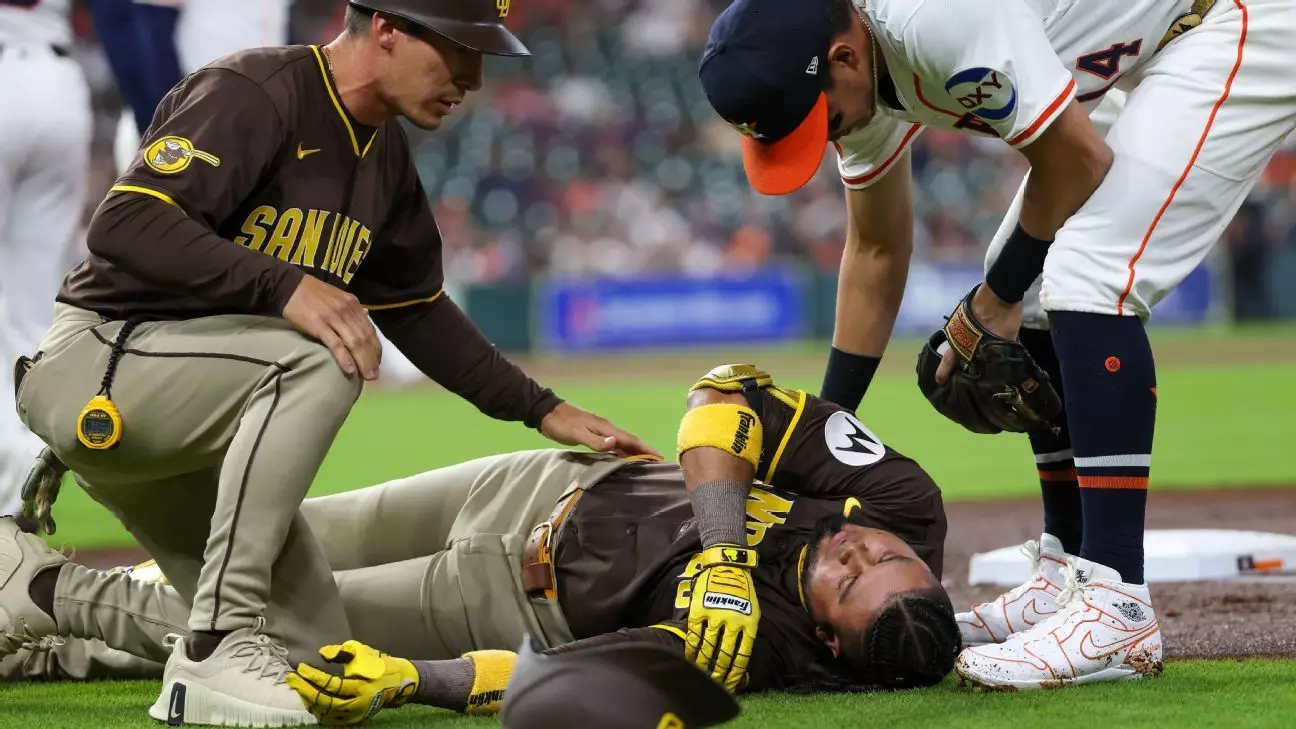On a seemingly ordinary night in Houston, a routine play escalated into a moment of overwhelming concern for the San Diego Padres and their fans. Luis Arraez, a celebrated three-time batting champion, found himself in a life-threatening situation following a severe collision at first base. As he attempted a deftly executed bunt, Arraez collided with Astros second baseman Mauricio Dubon, a scenario any baseball player fears. What made this incident particularly unsettling was the lack of movement from Arraez as he lay on the foul territory, instilling a sense of dread in those on and off the field. This is a profound reminder of the physical risks athletes face, particularly in a sport known for its brutality beneath the surface.
The unfortunate reality of professional sports is the ever-present risk of injury, exacerbated by the dynamic nature of the game. The mental and emotional toll such injuries take cannot be overstated. As players, coaches, and fans watched the aftermath of this collision unfold, it illuminated the fragile boundary between triumph and tragedy in baseball—where one moment can stand as a testament to skill, and the next can confront us with our own vulnerabilities.
The Immediate Impact on the Team
Following the incident, it was reassuring to hear the immediate assessment from Padres’ manager Mike Shildt, who described the situation as “favorable” given the grievous nature of the initial impact. The fact that Arraez returned to the ballpark after being taken to a hospital indicated a relief that was palpable among teammates and supporters alike. Shildt’s updates revealed that while Arraez was experiencing typical concussion symptoms—like stiffness and sore spots—there were no structural damages, a piece of news that offered a glimmer of hope during a tumultuous time.
The Padres have shown commendable resilience and depth by quickly recalling Mason McCoy from Triple-A El Paso to fill in for Arraez. This prompt decision was not merely a reactionary measure; it was emblematic of a team unwilling to crumble at the first significant hurdle of their season. Such organizational preparedness reflects the philosophy that champions don’t just rely on their star players to get by; they cultivate a sense of unity that allows them to weather the storm, irrespective of the circumstances.
The Emotional Aftermath
The emotional fallout from events like this extends far beyond the 90-feet between bases. As players like Dubon, Tatis Jr., and Machado witnessed Arraez being placed on a backboard and carted off, they were often reminded of the gravity behind the game. It’s a poignant juxtaposition; while the love for baseball thrives in every athlete, so too does anxiety about the precarious nature of their profession. Dubon voiced the burden athletes often bear, including the unwarranted threats and harassment that come from spectators and media when an injury occurs. His experience sheds light on a poignant truth: the emotional feedback loop surrounding professional sports can amplify stress and sorrow, even amid a community that is drawn together by the shared love of the game.
The camaraderie present in those nerve-racking moments can simultaneously forge bonds and reveal vulnerabilities, a duality that defines sportsmanship. While baseball is a game rooted in statistics and strategies, it thrives on the human experience, underscoring both personal hardships and collective resilience. In this context, it wasn’t merely about Arraez; it was about a community coming together in the face of adversity.
Looking Ahead: Arraez and the Concussion Protocol
As Arraez prepares to undergo further testing to assess his cognitive state, the team remains focused on his wellness and recovery. The implementation of the concussion protocol is a vital step in ensuring the safety and longevity of athletes, emphasizing that health should always take precedence over professional ambitions. It would be a grievous misstep to undervalue the role of medical evaluation in sports, especially for athletes like Arraez, who not only contribute to their teams but serve as inspirations for many aspiring players.
Arraez’s journey back to the field will undoubtedly be monitored closely, for he represents more than just batting averages and championships; he embodies the spirit of perseverance found within every competitor. The fact that he managed to return to his teammates post-incident holds a deep significance—a testament to the triumph of human spirit in adversity. With a career defined by remarkable skill, the hope for Arraez transcends mere statistics; it’s a collective wish for him to recover fully and return to what he does best, illuminating the sport and inspiring others along the way.
In the end, the incident serves as a critical reminder: in the world of sports, while skill may lead to achievements, humanity drives us all towards compassion and collective resilience.

